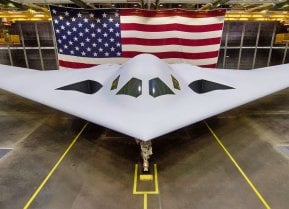Does Iran Have the Missiles to Sink a U.S. Navy Aircraft Carrier?
Iran has spent considerable time and effort building missiles that could attack U.S. aircraft carriers if a war ever broke out.
Is Iran Becoming a Missile Powerhouse? - On Sunday, Iranian state TV reported that the Islamic Republic's naval forces have taken delivery of new cruise missiles that could have a range of 1,000 km (621 miles). The Talaeiyeh and Nasir cruise missiles had reportedly arrived at a naval base near the Indian Ocean in the southern Iranian port of Konarak, some 1,400 kilometers (850 miles) southeast of the capital, Tehran.
Iran has claimed that the Talaeiyeh – since renamed Abu Mahdi – is a long-range "smart" missile that is able to change targets and adjust course during flight.
"The Talaeiyeh cruise missile has a range of over 1,000 km and is a smart missile that can change targets mid-mission," Admiral Shahram Irani told state media.
The shorter-range Nasir cruise missile can be employed on warships. It has a range of 100 km (62 miles).
Other Long-Range Weapons in Iran's Arsenal
Earlier this year, Tehran announced that the Abu Mahdi long-range anti-ship missile had entered service with the Islamic Republic of Iran Navy (IRIN) and the Islamic Revolution Guard Corps Navy (IRGCN).
Named after an Iraqi militia commander who was killed with the IRGC's Major General Qasem Soleimani in a January 2020 U.S. airstrike, the Abu Mahdi was unveiled in August 2020 and has a claimed range of more than 1,000 km (620 miles), Janes reported.
Iranian Rear Admiral Alireza Tangsiri, the commander of the IRGCN, said during the July ceremony in which the missiles were received, "One of the things that this missile can do is to repel the enemy, and it can drive the enemy away from our coasts."
Tangsiri further suggested that the missiles would force the U.S. Navy's aircraft carriers to withdraw so far that aircraft couldn't reach Iran. According to a report from the Tasnim News Agency, the dual-radar seeker has both active and passive modes and the missile's guidance system employs artificial intelligence (AI) to plot a flightpath via a series of waypoints, enabling it to exploit gaps in enemy air-defense coverage and enabling multiple missiles to approach a target from different directions simultaneously.
Should Washington Be Worried?
Tehran also claimed that reconnaissance helicopters, drones, and marine cruise missiles were among the latest weapons added to the navy's arsenal, Irani added, and further claimed, "All of this equipment has been designed and produced by Iran's military industry."
Although Western military analysts have noted that Iran often exaggerates its capabilities, Iranian-made missiles, and drones remain a key element in Tehran's military hardware.
"Iran announces the test firing, production and commissioning of new military equipment that cannot be independently verified. The country says it has a stock of various kinds of missiles with ranges up to 2,000 kilometers (1250 miles), capable of reaching Israel and U.S. bases in the region," The Times of Israel reported.
However, the announcement of the latest cruise missiles comes amid a wave of drone and missile attacks by Yemen's Iran-backed Houthi rebels on a vital shipping lane in the Red Sea, which they say is a response to the Israel-Hamas war in the Gaza Strip.
Tehran also backs the Palestinian militant group Hamas, which runs Gaza, as well as Hezbollah, another Islamist militant group in Lebanon. After Israel began its offensive in Gaza in response to Hamas' attacks on Israel in early October, the Houthis have targeted Israeli-linked shipping in the Red Sea as well as vessels belonging to large international shipping firms.
On Friday, the United States accused Iran of being closely involved in the recent attacks on commercial ships by Houthi rebels. Washington is considering tougher measures including possible force.
Could Iran Actually Sink a U.S. Navy Aircraft Carrier?
As previously reported, Iran has spent considerable time and effort building missiles that could attack U.S. aircraft carriers if a war ever broke out.
The U.S. Navy's nuclear-powered warships would be a tempting target, and even if Tehran couldn't sink one, it would be a devastating blow just to see a carrier take any damage in an attack. Even a near missile would be a propaganda coup for the Islamic Republic.
The U.S. Navy has seen its warships come under repeated attacks in recent weeks, and there is an increased risk of escalation. So far, the U.S. Navy has successfully countered the threat.
Yet, a key point remains true – namely that the U.S. Navy's warships need to remain ever vigilant and on the ball at all times. The crew also needs to do everything right every single time, while an enemy only needs to get lucky once! Iran may be building a lot of missiles to help its odds.
Author Experience and Expertise
Peter Suciu is a Michigan-based writer. He has contributed to more than four dozen magazines, newspapers, and websites with over 3,200 published pieces over a twenty-year career in journalism. He regularly writes about military hardware, firearms history, cybersecurity, politics, and international affairs. Peter is also a Contributing Writer for Forbes and Clearance Jobs. You can follow him on Twitter: @PeterSuciu.


